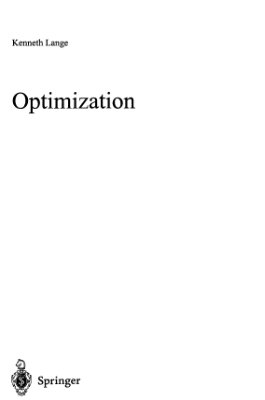Springer, 2004. - 252 Pages.
Finite-dimensional optimization problems occur throughout the mathematical sciences. The majority of these problems cannot be solved analytically. This introduction to optimization attempts to strike a balance between presentation of mathematical theory and development of numerical algorithms. Building on students’ skills in calculus and linear algebra, the text provides a rigorous exposition without undue abstraction. Its stress on convexity serves as bridge between linear and nonlinear programming and makes it possible to give a mode exposition of linear programming based on the interior point method rather than the simplex method.
The emphasis on statistical applications will be especially appealing to graduate students of statistics and biostatistics. The intended audience also includes graduate students in applied mathematics, computational biology, computer science, economics, and physics as well as upper division undergraduate majors in mathematics who want to see rigorous mathematics combined with real applications.
Chapter 1 reviews classical methods for the exact solution of optimization problems. Chapters 2 and 3 summarize relevant concepts from mathematical analysis. Chapter 4 presents the Karush-Kuhn-Tucker conditions for optimal points in constrained nonlinear programming. Chapter 5 discusses convexity and its implications in optimization. Chapters 6 and 7 introduce the MM and the EM algorithms widely used in statistics. Chapters 8 and 9 discuss Newton’s method and its offshoots, quasi-Newton algorithms and the method of conjugate gradients. Chapter 10 summarizes convergence results, and Chapter 11 briefly surveys convex programming, duality, and Dykstra’s algorithm.
Finite-dimensional optimization problems occur throughout the mathematical sciences. The majority of these problems cannot be solved analytically. This introduction to optimization attempts to strike a balance between presentation of mathematical theory and development of numerical algorithms. Building on students’ skills in calculus and linear algebra, the text provides a rigorous exposition without undue abstraction. Its stress on convexity serves as bridge between linear and nonlinear programming and makes it possible to give a mode exposition of linear programming based on the interior point method rather than the simplex method.
The emphasis on statistical applications will be especially appealing to graduate students of statistics and biostatistics. The intended audience also includes graduate students in applied mathematics, computational biology, computer science, economics, and physics as well as upper division undergraduate majors in mathematics who want to see rigorous mathematics combined with real applications.
Chapter 1 reviews classical methods for the exact solution of optimization problems. Chapters 2 and 3 summarize relevant concepts from mathematical analysis. Chapter 4 presents the Karush-Kuhn-Tucker conditions for optimal points in constrained nonlinear programming. Chapter 5 discusses convexity and its implications in optimization. Chapters 6 and 7 introduce the MM and the EM algorithms widely used in statistics. Chapters 8 and 9 discuss Newton’s method and its offshoots, quasi-Newton algorithms and the method of conjugate gradients. Chapter 10 summarizes convergence results, and Chapter 11 briefly surveys convex programming, duality, and Dykstra’s algorithm.

